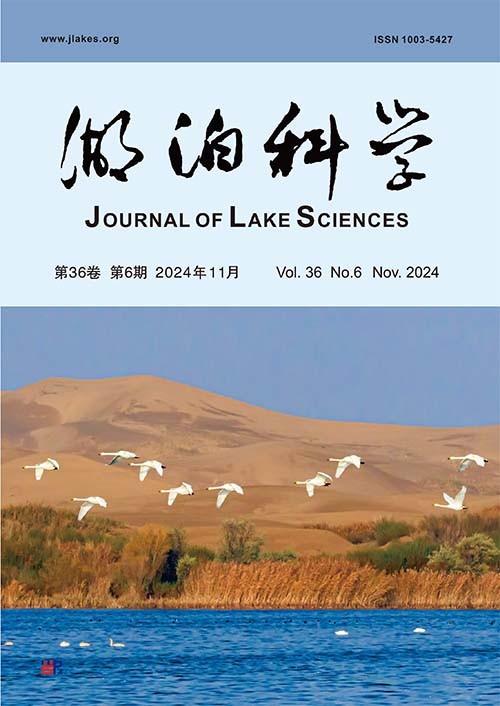Dynamic changes of genotypes of <i>Microcystis</i> CO<sub>2</sub>-concentration mechanism and their competitive effects on CO<sub>2</sub>
Q2 Earth and Planetary Sciences
引用次数: 1
Abstract
由于具有高效的CO2-浓缩机制,蓝藻在低CO2浓度条件下具有竞争优势。然而,随着大气中CO2浓度急剧增加,蓝藻CO2-浓缩机制如何响应的研究较少。因此,本文以常见水华蓝藻——微囊藻为研究对象,通过对滇池微囊藻水华动态及不同CO2-浓缩机制基因型进行监测,探讨蓝藻CO2-浓缩机制基因的微进化特征及其动态变化。同时,设置高(0.08%)、中(0.04%)、低(0.02%)CO2浓度(V/V)进一步揭示微囊藻不同CO2-浓缩机制基因微进化对CO2的竞争效应。结果表明:滇池无机碳浓度在4个采样点存在空间差异性,均呈现先降低后升高的趋势,并以HCO-3为主要无机碳存在形式。调查期间,东大河、观音山、洛龙河和生态所4个采样点的微囊藻均以sbtA基因型占绝对优势,相对丰度远高于bicA基因型。在不同水华时期,bicA基因型和sbtA基因型呈现相反的变化趋势,即从水华前期到水华中期,sbtA基因型的相对丰度逐渐升高,而到水华后期,出现bicA基因型增多的现象。室内竞争实验同样表明高浓度CO2培养环境下,bicA基因型具有明显竞争优势,随CO2浓度的降低,呈现bicA基因型向sbtA基因型转变的趋势。这些结果表明水华中期无机碳浓度相对较低,能适应碳限制环境的sbtA基因型的微囊藻表现出竞争优势,而对CO2浓度变化敏感的bicA基因型的微囊藻随无机碳浓度的升高逐渐增多;同时,在总碱度,pH和Chl.a影响下,微囊藻基因型在滇池不同微囊藻水华期呈现bicA→sbtA→bicA转变。这些结果说明微囊藻能通过调节不同CO2-浓缩机制基因藻株响应水体无机碳浓度,保持种群竞争优势,并维持水华的形成。;The highly efficient CO2 concentration mechanism (CCM) gives cyanobacteria a competitive advantage under low CO2 conditions. However, with the rapid increase in atmospheric CO2 concentration, little information has been presented on how the CO2 concentration mechanism of cyanobacteria responds. Therefore, this study takes a common blooming cyanobacterium, Microcystis, to investigate in the present by monitoring the dynamic changes and different CCM genotypes of Microcystis in Lake Dianchi. At the same time, the microevolutionary characteristics and dynamic changes of CCM genotypes in Microcystis were also discussed. Furthermore, the competing effects of different CCM genotypes in Microcystis at high (0.08%), medium (0.04%) and low (0.02%) CO2 concentrations (V/V) were compared. The results showed that the concentration of inorganic carbon (IC) in Lake Dianchi was spatially variable at four sampling sites, but all sites showed a trend of first decreasing and then increasing IC concentrations, and HCO-3 was the major form of IC. At the four sampling sites of DDH, GYS, LLH and STS, the sbtA genotype Microcystis was dominant and its relative abundance was much higher than that of the bicA genotype Microcystis. In different bloom periods, the bicA and sbtA genotypes of Microcystis showed opposite trends, i.e. the relative abundance of the sbtA genotype Microcystis gradually increased from early to mid- bloom, while the bicA genotype Microcystis increased only in late bloom. The competition experiments showed that the bicA genotype had an apparent competitive advantage in a high CO2 environment and showed a trend of transition from the bicA genotype to the sbtA genotype with decreasing CO2 concentration. These indicate that the IC concentration was relatively low in the middle of the bloom period, resulting in the sbtA genotype showing a competitive advantage in a carbon-limited environment, while the bicA genotype, a sensitive type to changing CO2 concentration, gradually increased with increasing IC concentration. In addition, the genotypes of Microcystis showed a bicA→sbtA→bicA transition during different Microcystis bloom periods in Lake Dianchi due to the effects of total alkalinity, pH and Chl.a. These results suggest that Microcystis can maintain its competitive advantage and sustain the bloom by regulating the algal strains with different CCM genotypes in response to the IC concentration in the water.微囊藻基因型的动态变化CO<sub>2</sub>-集中机制及其对CO<sub>2</sub>
由于具有高效的CO2-浓缩机制,蓝藻在低CO2浓度条件下具有竞争优势。然而,随着大气中CO2浓度急剧增加,蓝藻CO2-浓缩机制如何响应的研究较少。因此,本文以常见水华蓝藻——微囊藻为研究对象,通过对滇池微囊藻水华动态及不同CO2-浓缩机制基因型进行监测,探讨蓝藻CO2-浓缩机制基因的微进化特征及其动态变化。同时,设置高(0.08%)、中(0.04%)、低(0.02%)CO2浓度(V/V)进一步揭示微囊藻不同CO2-浓缩机制基因微进化对CO2的竞争效应。结果表明:滇池无机碳浓度在4个采样点存在空间差异性,均呈现先降低后升高的趋势,并以HCO-3为主要无机碳存在形式。调查期间,东大河、观音山、洛龙河和生态所4个采样点的微囊藻均以sbtA基因型占绝对优势,相对丰度远高于bicA基因型。在不同水华时期,bicA基因型和sbtA基因型呈现相反的变化趋势,即从水华前期到水华中期,sbtA基因型的相对丰度逐渐升高,而到水华后期,出现bicA基因型增多的现象。室内竞争实验同样表明高浓度CO2培养环境下,bicA基因型具有明显竞争优势,随CO2浓度的降低,呈现bicA基因型向sbtA基因型转变的趋势。这些结果表明水华中期无机碳浓度相对较低,能适应碳限制环境的sbtA基因型的微囊藻表现出竞争优势,而对CO2浓度变化敏感的bicA基因型的微囊藻随无机碳浓度的升高逐渐增多;同时,在总碱度,pH和Chl.a影响下,微囊藻基因型在滇池不同微囊藻水华期呈现bicA→sbtA→bicA转变。这些结果说明微囊藻能通过调节不同CO2-浓缩机制基因藻株响应水体无机碳浓度,保持种群竞争优势,并维持水华的形成。;The highly efficient CO2 concentration mechanism (CCM) gives cyanobacteria a competitive advantage under low CO2 conditions. However, with the rapid increase in atmospheric CO2 concentration, little information has been presented on how the CO2 concentration mechanism of cyanobacteria responds. Therefore, this study takes a common blooming cyanobacterium, Microcystis, to investigate in the present by monitoring the dynamic changes and different CCM genotypes of Microcystis in Lake Dianchi. At the same time, the microevolutionary characteristics and dynamic changes of CCM genotypes in Microcystis were also discussed. Furthermore, the competing effects of different CCM genotypes in Microcystis at high (0.08%), medium (0.04%) and low (0.02%) CO2 concentrations (V/V) were compared. The results showed that the concentration of inorganic carbon (IC) in Lake Dianchi was spatially variable at four sampling sites, but all sites showed a trend of first decreasing and then increasing IC concentrations, and HCO-3 was the major form of IC. At the four sampling sites of DDH, GYS, LLH and STS, the sbtA genotype Microcystis was dominant and its relative abundance was much higher than that of the bicA genotype Microcystis. In different bloom periods, the bicA and sbtA genotypes of Microcystis showed opposite trends, i.e. the relative abundance of the sbtA genotype Microcystis gradually increased from early to mid- bloom, while the bicA genotype Microcystis increased only in late bloom. The competition experiments showed that the bicA genotype had an apparent competitive advantage in a high CO2 environment and showed a trend of transition from the bicA genotype to the sbtA genotype with decreasing CO2 concentration. These indicate that the IC concentration was relatively low in the middle of the bloom period, resulting in the sbtA genotype showing a competitive advantage in a carbon-limited environment, while the bicA genotype, a sensitive type to changing CO2 concentration, gradually increased with increasing IC concentration. In addition, the genotypes of Microcystis showed a bicA→sbtA→bicA transition during different Microcystis bloom periods in Lake Dianchi due to the effects of total alkalinity, pH and Chl.a. These results suggest that Microcystis can maintain its competitive advantage and sustain the bloom by regulating the algal strains with different CCM genotypes in response to the IC concentration in the water.
本文章由计算机程序翻译,如有差异,请以英文原文为准。
求助全文
约1分钟内获得全文
求助全文
来源期刊

湖泊科学
Environmental Science-Water Science and Technology
CiteScore
3.70
自引率
0.00%
发文量
3253
期刊介绍:
Journal of Lake Sciences (ISSN 1003-5427) was founded in 1989 and is jointly sponsored by Nanjing Institute of Geography and Lake Sciences, Chinese Academy of Sciences and Chinese Society of Oceanology and Limnology. It mainly reports the latest research results on the changes in resources, ecology and environment of lakes (including reservoirs) and their basins under the interaction between man and nature. It publishes theoretical or applied research papers, briefs and reviews on various disciplines related to lake science (such as physics, chemistry, biology, ecology, geology, geography, etc.) as well as lake engineering and integrated basin management. Since 2006, the journal has been changed to a bimonthly publication, published on January, March, May, July, September and November 6 by Science Press.
 求助内容:
求助内容: 应助结果提醒方式:
应助结果提醒方式:


